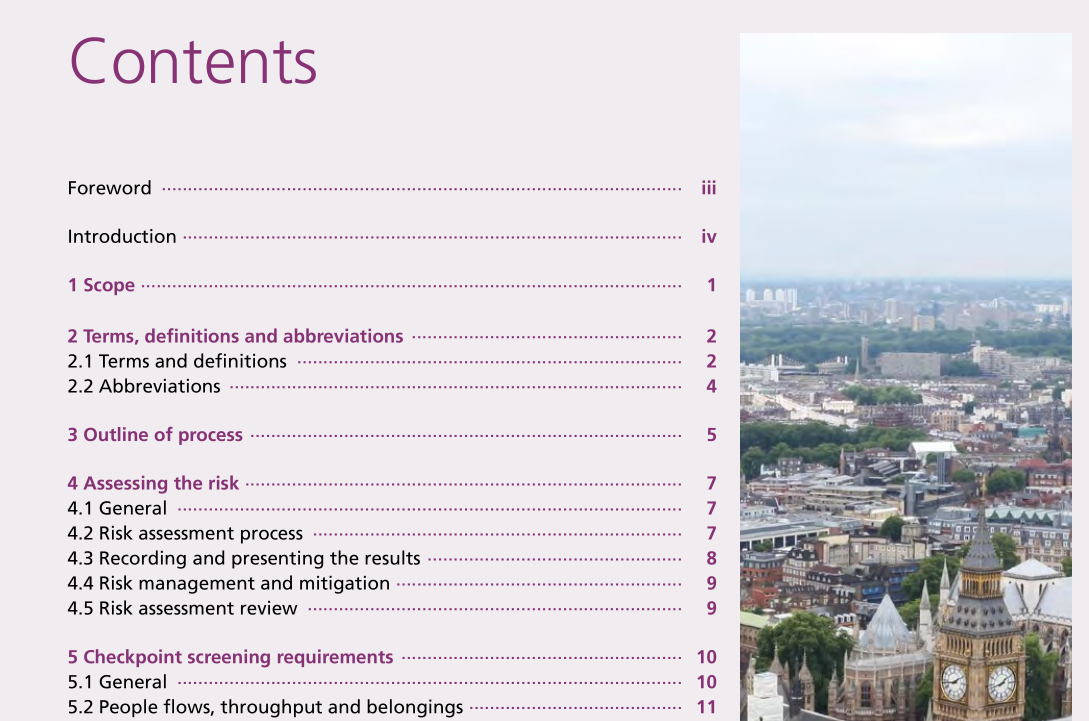PAS 127:2014 pdf download.Checkpoint security screening of people and their belongings – Guide
1 Scope
This PAS gives guidance and recommendations for checkpoint security screening of people, and their bags and possessions, for non-regulated applications. This includes both permanent and temporary installations at government and private buildings, events and sporting venues in public spaces or on private land. The PAS focuses on the detection of weapons and explosive threat items but the methodology can equally be applied to address other threats that an organization may face. This PAS is primarily aimed at anyone who has responsibility for planning and/or delivering security operations at venues in either the private or public sector. It will also be of interest to equipment manufacturers, procurement managers and policy makers. This document provides a framework for assessing risk and identifying screening requirements, and then specifying and delivering appropriate solutions. Key benefts and limitations of common screening methods and technologies are also summarized. The PAS has been deliberately kept fexible; users may tailor the recommendations to suit the particular requirements of their own organization or event, whilst still adhering to the principles of good practice.Security checkpoints rarely operate in isolation; recommendations for checkpoint screening are presented in the wider context of the organization’s security systems as a whole. These systems may, for example, include physical security measures such as closed-circuit TV surveillance (CCTV), and access control and personnel security, which may include accreditation of staff and visitors. Security staff form an integral part of any security system. Staff responsibilities are considered at all levels, from senior managers responsible for security or the commissioning of security services, through to the staff who carry out screening of individuals and bags or possessions. The importance of effective and relevant training of staff, maintaining staff motivation and ongoing monitoring of performance is also discussed. Aviation and other transport security screening are outside the scope of the PAS since these are subject to separate national and international regulation. However, it is important to note that nothing in the current PAS conficts with well-established aviation security screening procedures. Rather this document seeks to build on the best practices of aviation and other regulated transport security and to apply these to the non-regulated environment where appropriate. Where gaps have been identifed new guidance is provided. Whilst the prime focus of the PAS is screening for explosives and weapons, the screening procedures described can be adapted to detect or mitigate other types of threat such as: a) chemical, biological, radiological, nuclear (CBRN) materials; b) other illicit substances, such as narcotics; c) other items or materials that the organization might wish to prohibit on safety or security grounds, such as alcohol or medicines; d) items that may cause inconvenience or nuisance (such as musical instruments); e) theft of physical assets; f) industrial espionage; g) public disorder or criminal activity. This PAS does not cover: a) vehicle screening; b) mail screening (this is covered in PAS 97:2012, A specifcation for mail screening and security); c) defensive search of buildings or sites. NOTE Although specifc CBRN screening technologies and methods are beyond the scope of this PAS, measures associated with screening for explosives and weapons can also reduce the risk of CBRN threat items. If, following risk assessment, CBRN threat items are considered likely, expert advice should be sought.
2 Terms, defnitions and abbreviations
For the purposes of this PAS, the following terms and defnitions apply. NOTE BS EN 15602:2008, Security service providers – Terminology uses terms and defnitions that may have differing meanings to those below. 2.1 Terms and defnitions 2.1.1 assurance level of confdence or degree of certainty that a security screening system can detect and respond to a threat item, and thereby help prevent an attack 2.1.2 authorized personnel personnel in possession of such status as to allow access to areas via a different (lower) level of screening NOTE This status is usually achieved through security checks. 2.1.3 belongings individual’s personal possessions, which may include outer clothing, bags, portable electronic devices, wallets, keys, money, other carried items and tools-of- the-trade (2.1.30) 2.1.4 checkpoint defned search point where people can cross a boundary from an open unscreened area to a secure area where threat items and other designated items are prohibited 2.1.5 client groups different categories of persons requiring different levels of screening according to the risk they present NOTE These may for example be staff, visitors, spectators, VIPs, contractors or skilled manual workers. 2.1.6 demand rate at which an organization requires screening to be achieved 2.1.7 divest process of removing items from a person to improve the effciency and/or effectiveness of the screening process NOTE Examples include the removal of outer clothing and pocket contents.
PAS 127:2014 pdf download
